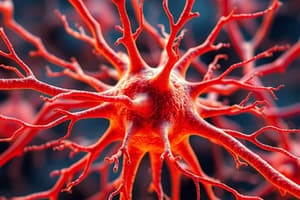Podcast
Questions and Answers
What is the role of neurotransmitters in nerve impulse transmission?
What is the role of neurotransmitters in nerve impulse transmission?
- Insulating the axon for faster transmission
- Detecting stimuli from the environment
- Exciting or inhibiting the activity of the next neuron (correct)
- Sending signals from the CNS to muscles and glands
Which of the following is NOT a type of neurotransmitter?
Which of the following is NOT a type of neurotransmitter?
- Serotonin
- Dopamine
- Myelin (correct)
- Glutamate
What determines the speed of an action potential along an axon?
What determines the speed of an action potential along an axon?
- The function of interneurons
- The neurotransmitter release
- The diameter of the axon (correct)
- The presence of myelin
What are the main functions of neurons?
What are the main functions of neurons?
Which part of a neuron is responsible for processing and integrating information within the CNS?
Which part of a neuron is responsible for processing and integrating information within the CNS?
What is the purpose of the synaptic cleft in neurotransmission?
What is the purpose of the synaptic cleft in neurotransmission?
What are the two main divisions of the nervous system?
What are the two main divisions of the nervous system?
Which part of a neuron contains the nucleus and most organelles?
Which part of a neuron contains the nucleus and most organelles?
What is the role of dendrites in a neuron?
What is the role of dendrites in a neuron?
What is the neurotransmission process?
What is the neurotransmission process?
Which part of the nervous system includes all nerves outside of the brain and spinal cord?
Which part of the nervous system includes all nerves outside of the brain and spinal cord?
What are nerves composed of?
What are nerves composed of?
Flashcards are hidden until you start studying
Study Notes
Introduction
The nervous system is a complex and sophisticated network of cells and fibers that allows humans and animals to interact with the world around them. It is responsible for controlling all vital functions, such as breathing, heart rate, and digestion, as well as higher cognitive functions, such as learning, memory, and problem-solving. In this article, we will discuss the components of the nervous system, including its divisions, neuron structure, neurotransmission process, nerve impulse transmission, and neuron function.
Nervous System Divisions
The nervous system is divided into two main parts: the central nervous system (CNS) and the peripheral nervous system (PNS). The CNS consists of the brain and spinal cord, while the PNS includes all the nerves outside of the brain and spinal cord. Nerves are bundles of axons, which are long fibers that transmit electrical impulses from one neuron to another.
Neuron Structure
Neurons, also known as nerve cells, are the basic building blocks of the nervous system. They come in various shapes and sizes, but all have three main parts: the cell body, dendrites, and axon. The cell body contains the nucleus and the majority of the cell's organelles. Dendrites are short, branching processes that receive incoming signals from other neurons. The axon is a long, slender process that transmits signals to other neurons.
Neurotransmission Process
Neurotransmission is the process by which neurons communicate with each other. It involves the release of a chemical messenger, called a neurotransmitter, from the axon terminal of one neuron into the synaptic cleft, a small gap between neurons. The neurotransmitter then binds to receptors on the dendrites or cell body of the next neuron, either exciting or inhibiting its activity.
There are many different types of neurotransmitters, including glutamate, GABA, serotonin, dopamine, and acetylcholine. Each type has specific roles in various physiological processes and can influence mood, cognition, and behavior.
Nerve Impulse Transmission
Nerve impulse transmission is the process by which electrical signals, known as action potentials, travel along the axon of a neuron. An action potential is an all-or-nothing response, meaning that it is either triggered or not, and once triggered, it travels along the axon at a constant speed. The speed of an action potential depends on the diameter of the axon and the presence of myelin, a fatty substance that insulates the axon and allows for faster transmission.
Neuron Function
Neurons have three main functions: sensing, processing, and responding. Sensory neurons detect stimuli from the environment and transmit this information to the CNS for processing. Motor neurons send signals from the CNS to muscles and glands, controlling movement and secretion. Interneurons are responsible for processing and integrating information within the CNS.
Conclusion
The nervous system is a complex and intricate network of cells and fibers that work together to control and coordinate the body's functions. Understanding the components of the nervous system, including its divisions, neuron structure, neurotransmission process, nerve impulse transmission, and neuron function, is essential for understanding how the body functions and how it responds to the world around it.
Studying That Suits You
Use AI to generate personalized quizzes and flashcards to suit your learning preferences.




